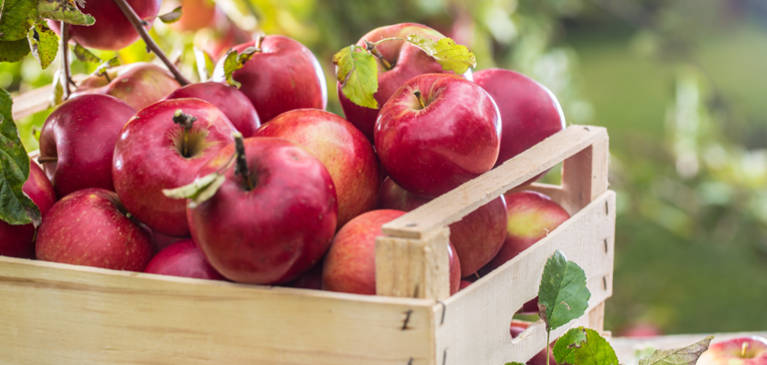
Apple Growers Expecting High-Performing Year
Michigan growers are calling the apple industry’s three-year bliss uncommon, but welcome, as growers are expected to haul in another above average crop for the third year in a row.
However, it is expected to be slightly below production of the previous two years. “With a wet spring and the following hot and dry weather, there were some quality issues – mainly apple scab – depending on the location,” said Travis Bratschi, GreenStone vice president of agribusiness lending out of Traverse City and an apple grower in Williamsburg, Michigan. “Even with irrigation, there has been some drought stress on trees. But, overall, it's a decent crop and there's some optimism pricing is a little bit better than last year.”
Few rain delays have allowed harvest to progress nicely, he adds. “Honeycrisp, with its rapid cell division earlier in the season when it was wet, has good-sized fruit, but Galas have been taking their time to size up,” Bratschi said.
Michigan, the third largest producing state behind Washington and New York, anticipates an apple crop of 30.5 million bushels (42 pounds per bushel), or 1.28 billion pounds. That’s well above Michigan historical 25.9-million-bushel average.
It’s been a trifecta for Michigan growers, as 2022 set a record-high with 32.38 million bushels of apples, while last year was right behind with 31.9 million bushels.
“It is unusual to have three large crops in a row,” said Diane Smith, executive director of the Michigan Apple Committee. “However, as growers continue to plant high-density orchards and adopt other innovative growing practices, Michigan’s apple crop sizes will increase, and we will continue to see these larger crops.”
After record-breaking production in the U.S. last year, apple growers across the country are expecting another high-performing year, according to a new report released by the U.S. Apple Association (USApple).
Total U.S. apple production for the 2024/25 crop year will be almost 260 million bushels, representing a 10.1% decrease compared to last year’s final production figure, according to USApple. Although the apple production will be lower than last year, growers are expecting a high-quality crop.
“Growers from across the U.S. are reporting the crop quality is excellent,” said USApple Vice President of Insights and Analytics, Chris Gerlach.
Wisconsin Apple Outlook
USDA does not predict Wisconsin apple production, but Antonia (Toni) Sorenson, GreenStone Farm Credit Services vice president of traditional lending based out of Sturgeon Bay, Wisconsin, said, “Despite in-orchard challenges, overall yields are slightly below average this year. Depending on what part of the state you are located, varieties are about 1-2 weeks ahead of a normal ripening schedule.”
Wisconsin Apple Growers Association represents 170 commercial apple growers from across the state.
Commercial orchards are found in 46 of Wisconsin's 72 counties, comprising about 7,400 acres and producing about 56 million pounds of fruit worth over $9 million per year.
“The Wisconsin apple crop, like every other crop this year, has been a challenge to grow unscathed,” said Sorenson. “Spring presented with excessive moisture, and late summer and into fall has had drought-like conditions. Even under ridged application schedules and constant weather monitoring, controlling insect populations and foliar diseases has been a bigger challenge than many previous growing seasons. Most growers seem to be hoping for more a normal Wisconsin winter to help curb these unwelcome insect populations back to normal levels.”
With an early, warm spring, and with no frost to follow, Michigan also is experiencing an early harvest putting fresh market apples in consumers’ hands two weeks early.
That’s in sharp contrast to 2012, when 90% of Michigan’s apple crop was killed before it really started with 80-degree days in March followed by some freezing April nights.
Hard Cider Boom
Michigan hard cider, now available in all 50 states, has carved out a new market for the apple industry.
The popularity of craft beverages has grown immensely in the last 20 years, and hard cider has quickly become one of the fastest-growing sectors within the industry.
From 2008 to 2019, the number of hard cider drinkers increased from 6.8 million to 24.5 million. There are nearly 200 wineries and cideries that produce hard cider in Michigan.
Michigan Apple Exports on the Rise
The Michigan apple industry has seen a steep increase in apple exports since 2020, with bushels shipped increasing by 40%, according to the U.S. Apple Export Council.
In 2023, Michigan exported 147,917 bushels, with a value of $3.1 million, to Canada, Central America, Colombia, Mexico, Southeast Asia and the Caribbean.
Formed in 1993, the U.S. Apple Export Council (USAEC) represents five apple-producing states, California, Michigan, New York, Pennsylvania, and Virginia, promoting and seeking to expand U.S. apples in many international markets. In total, all five state members of the USAEC brought a value of nearly $13 million through exports, moving 534,453 bushels of apples into global export markets.
According to Smith, Michigan apples are sold in 32 states and 18 countries. “Honeycrisp, Gala, Fuji, and Red Delicious are the most popular, with Gala being the most produced. EverCrisp and Ambrosia continue to gain popularity.”
Freight charges make it cost-prohibitive to market west of the Rockies, but Michigan apples do make it to Florida, where many Michigan residents – who seek Michigan apples – like to overwinter.
Expanding the Michigan Apple Market
With the focus on increasing consumption of Michigan apples through a mix of social media, advertising, events and partnerships, the Michigan Apple Committee has launched a back-to-school campaign, which it plans to follow with new initiatives slated for the next several months.
The Michigan apple industry has more than 14.9 million trees in commercial production, covering 34,500 acres on 775 family-run farms.


